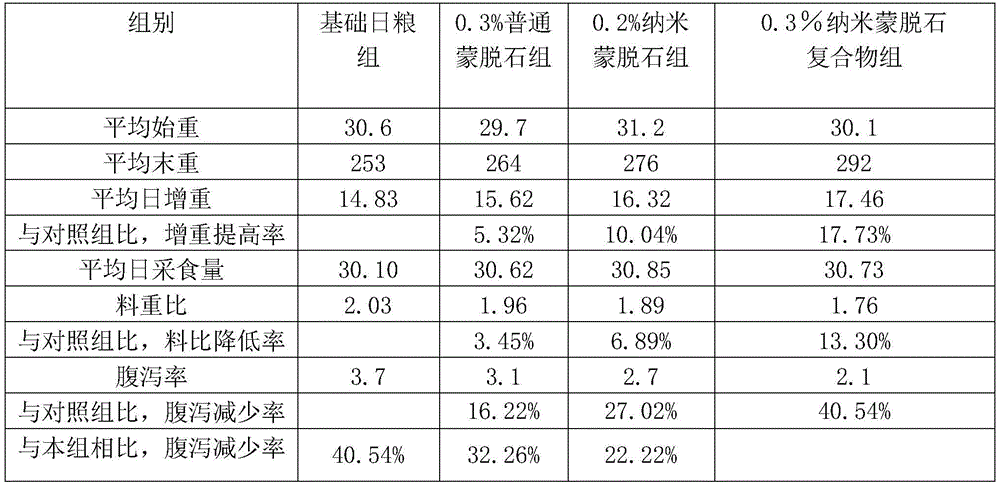Nanometer montmorillonite feed additive compound for detoxifying and diarrhea prevention of livestock and poultry
A nano-montmorillonite and feed additive technology, applied in animal feed, additional food elements, applications, etc., can solve the problems of livestock and poultry ecological environment and human health threats, intestinal mucosal epithelial cell shedding, electrolyte dysfunction, etc., to avoid Drug resistance, strong adsorption function, and the effect of improving the survival rate
- Summary
- Abstract
- Description
- Claims
- Application Information
AI Technical Summary
Problems solved by technology
Method used
Image
Examples
Embodiment 1
[0012] Embodiment one, a kind of nano-montmorillonite feed additive compound that is used for livestock and poultry detoxification and anti-diarrheal, is made up of nano-montmorillonite, organozinc, glucose oxidase, xylo-oligosaccharide and glucose; Said nano-montmorillonite The mass percentages of stone, organic zinc, glucose oxidase, xylooligosaccharide and glucose are: 54.0% of nano-montmorillonite, 20% of zinc glycinate, 10% of xylooligosaccharide, 1.0% of glucose oxidase, and 15% of glucose.
[0013] In this embodiment, the particle size of the nano-montmorillonite is ≤200 nanometers, the pore diameter of the nano-montmorillonite is 5-100 nanometers, and the specific surface area is ≥300m 2 / g, bulk density is 0.3-0.6(kg / m 3 ).
[0014] Of course, the organozinc in the present invention can also be one of zinc citrate, zinc gluconate, zinc methionine or zinc licorice.
Embodiment 2
[0015] Embodiment two, this embodiment is basically the same as embodiment one, the difference is: the mass percentage of described nano-montmorillonite, organozinc, glucose oxidase, xylo-oligosaccharide and glucose is: nano-montmorillonite 82.8%, Zinc glycinate 10%, xylooligosaccharide 2%, glucose oxidase 0.2%, glucose 5%.
[0016] Glucose oxidase can catalyze glucose in the intestinal tract to produce gluconic acid and hydrogen peroxide. When hydrogen peroxide accumulates to a certain concentration, it can directly inhibit the growth and reproduction of Escherichia coli, Salmonella, Pasteurella, Staphylococcus and Vibrio. Its mechanism of action is completely different from that of antibiotics, and it will not produce bacterial resistance or drug residues. Glucose oxidase can catalyze glucose to remove oxygen in the intestine, creating an anaerobic environment for the proliferation of anaerobic beneficial bacteria Bifidobacteria. The generated gluconic acid can lower the pH...
Embodiment 1
[0020] Embodiment 1, the present invention is aimed at the effect test of weaned piglets
[0021] 1. Experimental design: 128 weaned piglets with an average body weight of 6.0 ± 0.2 kg were selected at 25 days of age, and they were randomly divided into 4 groups: (1) the control group was fed a basal ration (0.02% of 10 % colistin sulfate); (2) ordinary zinc oxide group: add 0.3% ordinary zinc oxide on the basis of the basic diet; (3) ordinary montmorillonite group: add 0.3% ordinary montmorillonite on the basis of the basic diet (4) Nano-montmorillonite composite group: add 0.3% special nano-montmorillonite composite group on the basis of basal diet. Each group was treated with 4 replicates, each replicated with 8 pigs. The feeding period is two weeks after weaning, a total of 14 days.
[0022] 2. During the test period, observe the feed intake and drinking water of each pig group, and record the feed consumption and diarrhea of suckling pigs. Measure the body weight 21 ...
PUM
 Login to View More
Login to View More Abstract
Description
Claims
Application Information
 Login to View More
Login to View More - R&D Engineer
- R&D Manager
- IP Professional
- Industry Leading Data Capabilities
- Powerful AI technology
- Patent DNA Extraction
Browse by: Latest US Patents, China's latest patents, Technical Efficacy Thesaurus, Application Domain, Technology Topic, Popular Technical Reports.
© 2024 PatSnap. All rights reserved.Legal|Privacy policy|Modern Slavery Act Transparency Statement|Sitemap|About US| Contact US: help@patsnap.com









